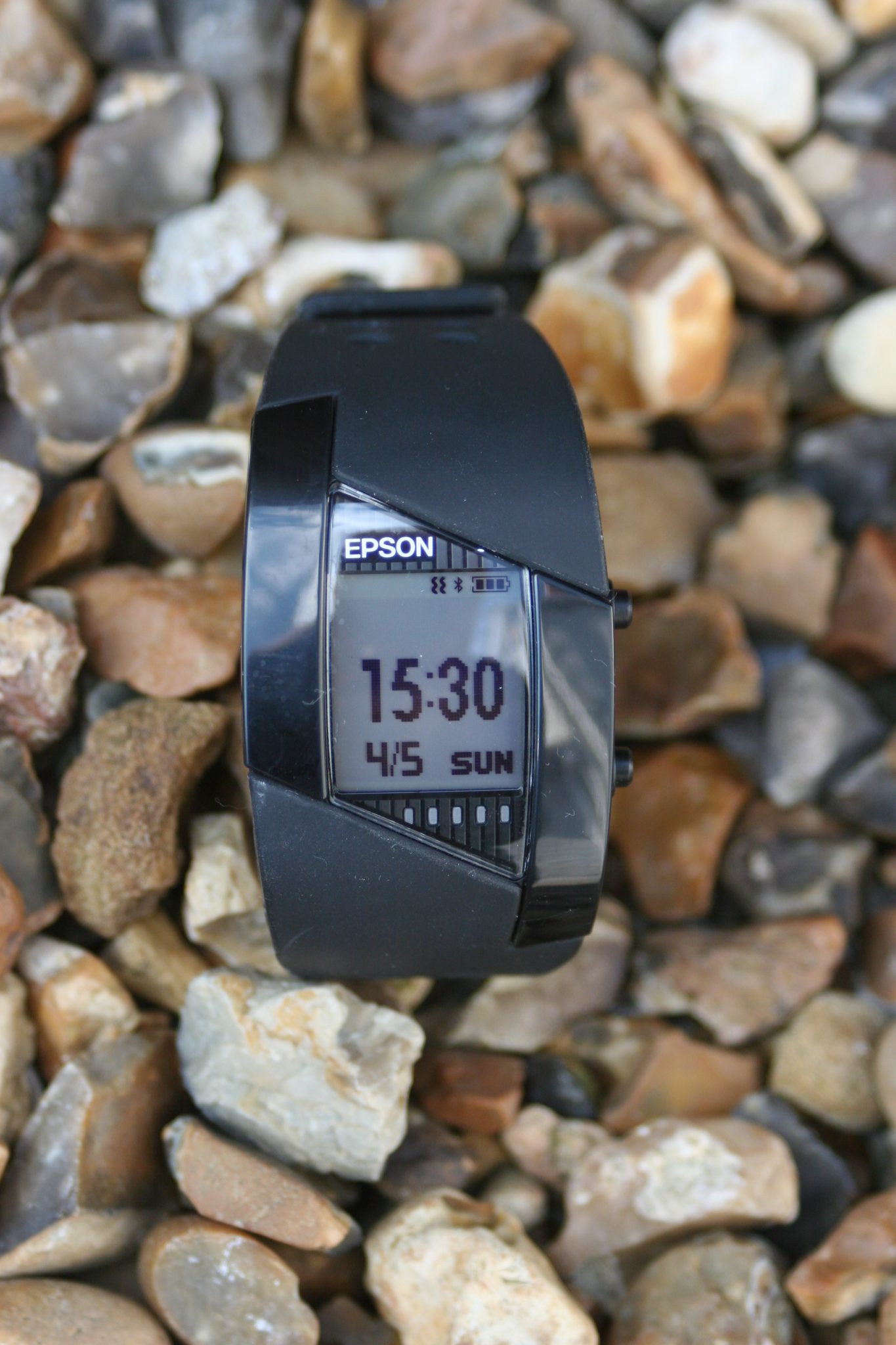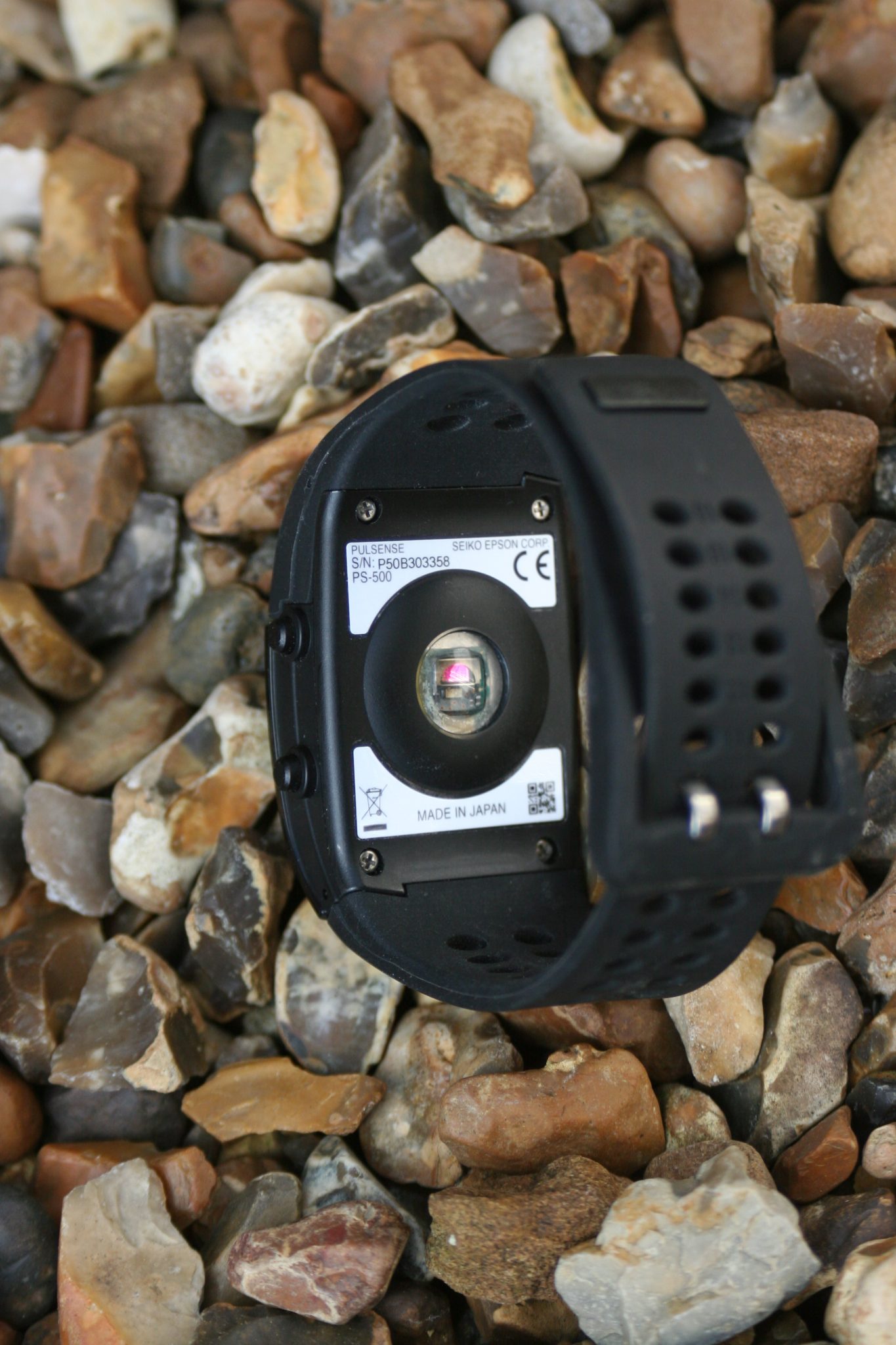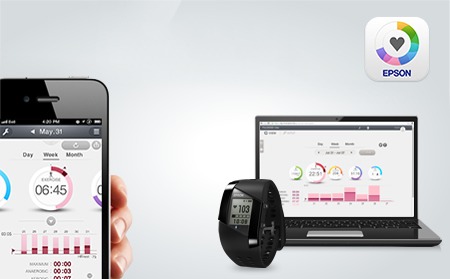
The Epson Pulsense PS-500 is a wrist worn activity tracker. It’s builds upon Epson’s own optical heart rate (HR) technology and their pedigree of watch-making through their ownership of Seiko.
The genre of products that use wrist-worn optical technology mark the lead of the third wave of wrist-wearable activity tracking; moving on significantly from the glorified pedometers from other manufacturers in previous years and before that the simple pedometers.
In my opinion you simply must base your analysis of INactivity (sleep, for example) on resting HR (or other more complex HR-related measurements). You simply also have to measure ‘proper’ sporting activity such as jogging or a ‘class’ through elevated heart rates and, ahem, you obviously need a heart rate monitor to do that. And of course you don’t really want to wear a HR chest strap and certainly not in bed.
Next you have to have a comfortable, good looking device that has a simple yet intuitive interface and a Bluetooth link to a half-decent smartphone app and, furthermore, that heart rate monitor should NOT rely on there being a constant connection to that smartphone. Coupled with all of this a fully charged battery needs to last as long as possible; 1 day at the VERY least of 24×7 wearable time.
EDIT: PRICE CHANGE. At less than £100 this represents serious value for money (see below).
You’d be surprised just how many products out there do not do all of this. VERY many of them don’t. That’s OK, though. Those other (first/second generation) activity products probably have their other strengths. Choose wisely.
Anyway; as you’ve probably guessed, the Epson Pulsense PS-500 does all that I think a proper third generation activity tracker needs to. There is an impending fourth generation but there are no products yet for sale that I would put in that category (look for 2016 and beyond).
Quite a few devices come across my desk and to be honest many of them are not exciting; even in any specific aspect. I admit to passing on the Pulsense to a colleague without looking at it at all. The next day I had some feedback.
It’s perfect, it’s just what I need. It does everything I want.
So. On that somewhat unambiguous note I quickly re-took possession and settled down for a MUCH closer inspection. My apologies to Mr Epson for not doing that initially !!
The great thing with Epson is that we can all approach the product with few, or no, preconceptions. We all just ‘know’ that if I were reviewing the Microsoft BAND or the Apple iWATCH or the Samsung GEAR then there would be zealots from either camp loving their brand and, probably, despising the others. The same is probably true to a lesser degree for FITBIT, Garmin, Polar, MISFIT, JAWBONE and others.
With Epson, well, if it’s good I’ll say so and if not…I’ll say so based solely on what it is.
Unboxing
 It’s a fairly standard box (is that important?) and it has a USB charging cradle along with the watch/activity tracker. Fine.
It’s a fairly standard box (is that important?) and it has a USB charging cradle along with the watch/activity tracker. Fine.
Here is a rear shot of the proprietary optical heart rate. It bounces a laser off your skin and your skin vibrates with your heartbeat. That’s about all you need to know.

It has 3 controls: a double tap on the face (you tap it quite firmly) and an upper (A – select) and lower (B – ‘navigate’ or press and hold to go back) button on the right hand side of the device. It has 5 LEDs beneath an LCD display.

Setting Up
I had some problems with setting the device up but eventually sorted it out.
To progress with installing the Epson PULSENSE View application (PC or smartphone) you need to create an account. I had problems receiving the confirmation email but eventually managed to send it to an account on a smartphone.
You need to use the PC based PS Uploader Software to create an account, or at least that’s how I did it. The PS Uploader Software also kindly updated the firmware for me as well.
Then you need to follow closely the on-screen instructions (or in the manual – see link below) to pair the device to your mobile phone.
With some older smartphones there are vagaries in the implementation of Bluetooth Low Energy (BTLE or V4). So, for example, on my Samsung S3 it won’t work but on a Samsung S4 and above it would work, even though both support ‘Bluetooth’. Several other apps I have worked with have the same problem with an inability to pair. Some will pair within an APP even though the device is invisible to the phone’s normal Android Bluetooth pairing settings.
I managed to get the app working on an iPAD3 Revolution A1416 (iOS 8.1.1), although there were some screen sizing/display issues suggesting that the APP has been designed primarily for the Apple SMARTPHONE. Not to worry, it was quite usable on the iPAD.
This all seemed a bit more complex than it needed to be. Still once it’s done it’s done. Moving on.
Using it
Here are some features and stats that define the limits of how you can use it:
- 480 hours of internal storage
- Water resistant to 3ATM (30m)
- 36 hour battery life
- Vibrate alert
- HR Zone measurement
- Sleep-type measurement
- Progress against targets
- Steps and distance counter (no GPS)
- Calories burned (calories eaten can be manually entered)
- Mind-state – elevated or relaxed.
- LCD display
Connectivity and Ways to use
- You can look at PULSENSE on either the web or your smart device (iOS or Android, check older OS versions for compatibility)
- Data is STORED IN THE DEVICE ITSELF – up to 480 hours capacity. Either the PC-USB cable OR the Bluetooth on your smart device can be used to UPLOAD your data to PULSENSE.
- The USB cradle is the only way to charge the device and it can plug into either a PC USB port or a main USB adapter port.
Using the watch
The LCD display is clear and straightforward and is augmented beneath with 4 small blue LEDs and one orange LED.
When you put the watch on, ensure it is clear of your wrist bone and tap it twice and press the top button (A). You need to do this each time you put the watch on to start HR recording.
After that it does lots of clever stuff, automatically turning itself on and off every 4 seconds to continually measure HR. Furthermore it initially estimates your HR zones based on your age profile. This is normal but inaccurate. As your usage progresses it re-evaluates the zones based on actual readings of, for example, your nightly resting HR. None of this is rocket science, however there are VERY few other products that can do this same thing with a wrist-only based device.
Even my top-of-the-range >£300 Garmin triathlon watch cannot do this…
The watch can be used to display HR, HR Zone, calories, steps, distance. The display IS rudimentary. However if your HR is 148bpm then, really, how many exciting ways do you really want to show that one simple piece of data? The PULSENSE PS-500 does the job.
Here is an example of the watch screen and navigating through various displays

The device WILL be criticised by some for the simplicity of the display. Devices will always be criticised because we keep saying we need more and more. I think back to the MIO Link – an almost universally liked, for what it was, wrist HR Band with NO DISPLAY. It was criticised by many on one thing “if only it could JUST have a simple display as the LEDs aren’t enough”. Of course then with that simple display added we, sort of, have the PS-500 !! Yet the same people will then want a more fancy display (and the shorter battery life that will come with it). And so it goes on.
Well, the more fancy display is the smartphone (or PC) PULSENSE app (These images are Epson images).

Here you can see your HR and HR Zone (‘fat burning’ zone) in ‘real time’.
The app has some good views of the data. Here you can see that view can be across the hours of individual days and there are aggregate weekly/monthly views.

Similar aggregate and detail views are available with calories and, as you can see, upper and lower calories levels are shown too as well as calories consumed (manually input) and spent (calculated).

Same sort of thing with steps.

I particularly like the sleep tracking which also estimates your ‘deep’ sleep durations as well.
![]()
I’m not quite sure how the ‘state of mind’ works. I would imagine that relaxed would be from, as shown, a bit of yoga or perhaps also an afternoon nap not properly registered as sleep. High heart rates when not exercising I imagine would count as stress, perhaps also coinciding with an elevated resting HR.

You can track progress against targets:

APP Compatibility
I could only get the PS-500 to work with the Epson software.
Accuracy – Speed, Distance, Number of Steps, Calories, HR
Deliberately blank. This section will be added after more detailed investigation. My only area of concern, in general, for this type of device would be the accuracy of the HR at high values where optical HR monitors tend to fair worse than their chest-based counterparts.
Edit: Steps. This seem VERY accurate. On a recent drive my Garmin 920XT (£300+) calculated over 1000 steps WHILST DRIVING and the Epson counted 5. So the Epson was out by 5 and the Garmin out by a few more 🙂
The other parameters noted (eg number of steps) will always be wrong to some degree. The consistency of your measurement method is the important thing ie using the same device each time.
GPS
There is no link to GPS pace/speed data, even from the smartphone app. You need the RUNSENSE product in order to do that.
Price Comparison
After recent reductions, it’s priced about right and will eventually fall to around £100 (2016) (Edit : sooner than I thought!)
| Black Friday 2015 | Amazon Price | |
| Basis Peak | £149.99 | Link |
| Epson Pulsense PS100 | £42.99 | Link |
| Epson Pulsense PS500 | £79.99 | Link |
| Fitbit Charge | £49.00 | Link |
| Fitbit Charge HR | £74.99 | Link |
| FitBit Flex | £112.00 | Link |
| Fitbit One | £58.65 | Link |
| Fitbit Surge Ultimate | £142.49 | Link |
| Fitbit Zip | £49.70 | Link |
| Fitbug Orb | £30.95 | Link |
| Garmin Forerunner 15 | £79.99 | Link |
| Garmin Vivoactive | £123.31 | Link |
| Garmin Vivofit | £44.98 | Link |
| Garmin Vivofit2 | £73.95 | Link |
| Garmin Vivosmart | £79.99 | Link |
| Jawbone UP24 | £52.89 | Link |
| Jaybird Reign | £179.99 | Link |
| Microsoft Band | £89.00 | Link |
| Milestone Altitude | £28.91 | Link |
| Mio Fuse | £94.95 | Link |
| Misfit Shine | £59.99 | Link |
| Nike+ Fuelband | n/a | Link |
| Polar Loop | £45.60 | Link |
| Polar A360 | £131.32 | Link |
| Samsung Gear Fit | £63.99 | Link |
| sony Mobile SWR10 | £29.89 | Link |
| Timex Move x20 | £50.55 | Link |
| Withings Pulse | £54.99 | Link |
SUMMARY
I like it. The person who ‘borrowed’ it absolutely loved it. It’s geared to someone who wants to get fit and wants to ‘properly’ track their activity and sleep. If you want to do more serious run TRAINING (rather than general jogging as exercise) then the RUNSENSE product is for you. Or maybe you buy this and also buy a GPS running watch and leave this unit on charge while you run.
Pricing is about right and I like the look and feel of the product which comes across as being well made.
Battery life is MUCH longer than the Apple iWATCH !! but this would be the one area that I would ask for an improvement on over time.
Accuracy seems very good for the step counter. The sleep tracker seems initially wrong BUT after a week or so seems to learn and then seems very accurate. The historic data also seemed to be corrected after that week. Maybe I imagined that.
Others don’t like the aesthetics and I would say that the setup was more convoluted that it needed to be. Once through that the app is excellent for its intended market.
Resources:
Epson video
<Here> is the Epson Pulsense PS-500B Manual
Functions
| Target setting | Steps, Weight, Time in fat burning zone, Calories burned per day, |
| Automatic tracking | Heart rate zone training, Heart rate activity tracking, Heart rate based calories burned tracking, Sleep Quality tracking, Sleep AutoDetect, Sleep phase wake up alarm, Steps and distance tracking |
| Manual tracking | Calorie intake tracking, Weight tracking, Body Fat % tracking |
| Notifications | Weekly Summary Emails, E-mail, Incoming Call, Schedule Alerts |
Measurements
| Steps | Yes |
| Distance | Yes |
| Calories Burned | Active, Inactive |
| Mind | Elevated, Relaxed |
| Exercise | Above fat burning zone, Fat burning zone, Below fat burning zone |
| Sleep | Still, Restless |
| Instant Heart Rate | Below fat burning zone, Fat burning zone – Low, Fat burning zone – Mid, Fat burning zone – High, Aerobic, Anaerobic, Maximum |
General
| Width | Max. 35 mm |
| Thickness | Max. 14 mm |
| Weight | 44 g |
| Wrist Size | 140-190 mm |
| Battery life (heart rate on) | 36 hrs |
| Battery type | Lithium Polymer 75mAh |
| Water resistant | 30m |
| User interface | 2 buttons + tap |
| Vibrate | Yes |
| History capacity | 480 hr |
| Connection to Computer | USB |
| Connection to Smart phone | Bluetooth 4.0 |
| Heart Rate Monitor | Optical |
| Multi axis accelerometer | Yes |
| LCD Display | Yes |
| 5 LED HR Zone indicator | Yes |
| Pulsense View web app | Yes |
| Supported web browser | Safari, Chrome, Firefox, Internet Explorer 9 or later |
| Pulsense View smart phone app | Yes |
| Supported smart devices | For the latest compatibility please go to https://www.epson.co.uk/pulsense |
| Supported OS | Windows Vista SP2, Windows 7 SP1, Windows 8, Windows 8.1 |
| What’s in the box | Cradle, Information sheet, Main unit, Quick Start Guide |


Surely this is a joke. It looks terrible!
Thank you for your feedback.
Not to everyone’s taste admittedly. Then again neither was the Garmin 620 nor the Garmin 920XT and they sold quite well !
Epson also have their RUNSENSE products that are more conventional round-faced looking watches